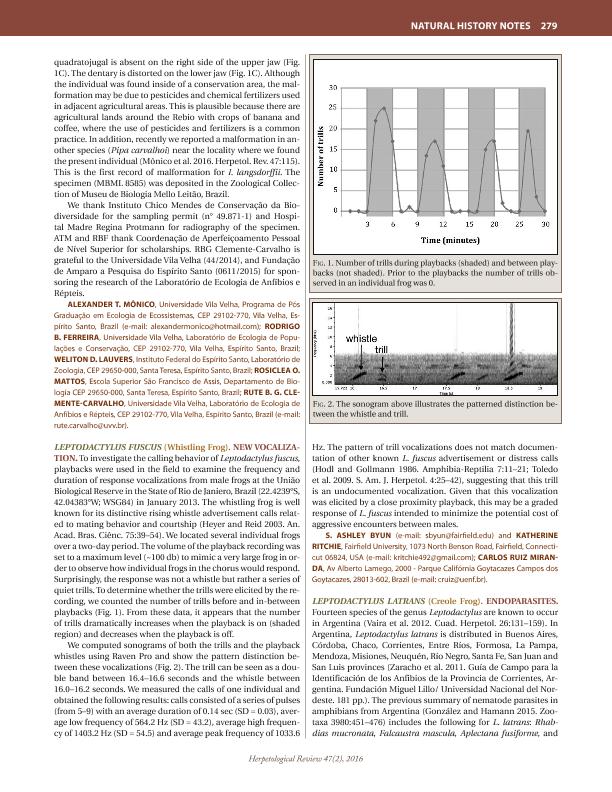Artículo
Leptodactylus latrans (Creole Frog). Endoparasites
Ramallo, Geraldine; Bursey, Charles; Goldberg, Stephen; Castillo, Gabriel Natalio ; Acosta, Juan Carlos
; Acosta, Juan Carlos
 ; Acosta, Juan Carlos
; Acosta, Juan Carlos
Fecha de publicación:
06/2016
Editorial:
Society for the Study of Amphibians and Reptiles
Revista:
Herpetological Review
ISSN:
0018-084X
Idioma:
Inglés
Tipo de recurso:
Artículo publicado
Clasificación temática:
Resumen
Fourteen species of the genus Leptodactylus are known to occur in Argentina (Vaira et al. 2012. Cuad. Herpetol. 26:131?159). In Argentina, Leptodactylus latrans is distributed in Buenos Aires, Córdoba, Chaco, Corrientes, Entre Ríos, Formosa, La Pampa, Mendoza, Misiones, Neuquén, Río Negro, Santa Fe, San Juan andSan Luis provinces (Zaracho et al. 2011. Guía de Campo para la Identificación de los Anfibios de la Provincia de Corrientes, Argentina. Fundación Miguel Lillo/ Universidad Nacional del Nordeste. 181 pp.). The previous summary of nematode parasites in amphibians from Argentina (González and Hamann 2015. Zootaxa3980:451?476) includes the following for L. latrans: Rhabdias mucronata, Falcaustra mascula, Aplectana fusiforme, and Microfilaria tamborinii. In this paper we present a record of a new nematode parasite in L. latrans from Argentina. Five L. latrans (two males: SVL = 92 and 111 mm; two females:SVL = 83 and 98 mm; one juvenile SVL = 71 mm) were collected in April 2014 from La Majadita (30.6867°S, 67.5039°W, WGS84; 952 m elev.), Valle Fértil Department, Province of San Juan, Argentina. They were deposited in the Herpetology Collection Universidad Nacional de San Juan (UNSJ 1754?1758). The body cavitywas opened by a mid-ventral incision and the digestive tract was removed. The esophagus, stomach, and intestines were longitudinally slit and the contents were examined for helminths using a dissecting microscope. The only helminths found were 97 nematodes in the large intestines. The prevalence of infectionwas 100% with a mean intensity of 19.4 ± SD 4.7 (range = 15?26) nematodes per frog. They were cleared in a drop of lactophenol, placed on a glass slide, coverslipped, studied under a dissecting microscope and identified as Falcaustra sanjuanensis. They were deposited in the Helminthological Collection, Fundación Miguel Lillo as F. sanjuanensis (CH-N-FML 07582, 07583). Falcaustra sanjuanensis was described from the anuran Odontophrynus cf. barrioi (González et al. 2013. Acta. Parasitol. 58:119?125) and Lithobates catesbeianaus (González and Hamann2015, op. cit.). The specimens of F. sanjuanensis identified herein possess the characteristics diagnosis of the species, especially the unpaired papilla anterior to the anus located on a protuberance. Falcaustra sanjuanensis in L. latrans is a new host record.
Palabras clave:
NEMATODE PARASITE
,
LEPTODACTYLUS LATRANS
,
FALCAUSTRA SANJUANENSIS
,
ARGENTINA
Archivos asociados
Licencia
Identificadores
Colecciones
Articulos(CCT - SAN JUAN)
Articulos de CENTRO CIENTIFICO TECNOLOGICO CONICET - SAN JUAN
Articulos de CENTRO CIENTIFICO TECNOLOGICO CONICET - SAN JUAN
Citación
Ramallo, Geraldine; Bursey, Charles ; Goldberg, Stephen; Castillo, Gabriel Natalio; Acosta, Juan Carlos; Leptodactylus latrans (Creole Frog). Endoparasites; Society for the Study of Amphibians and Reptiles; Herpetological Review; 47; 2; 6-2016; 279-280
Compartir



